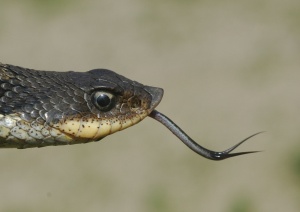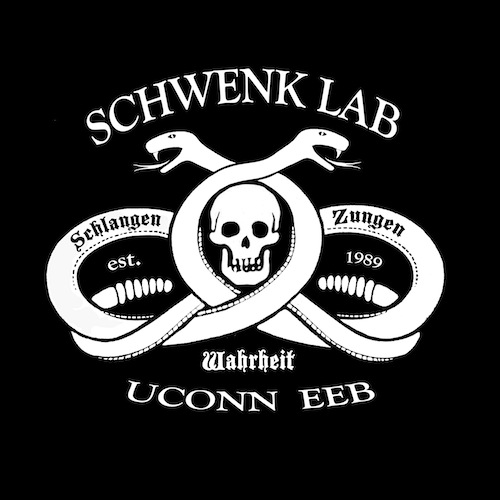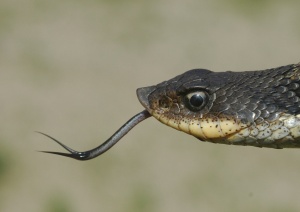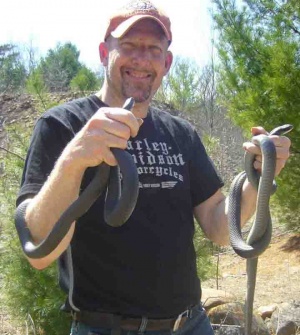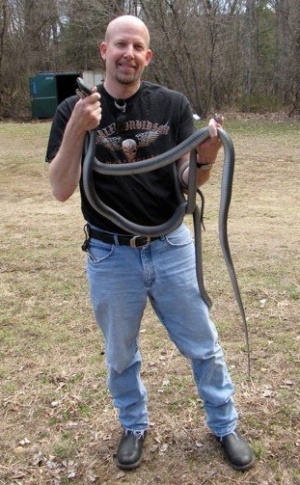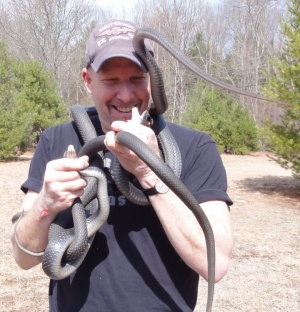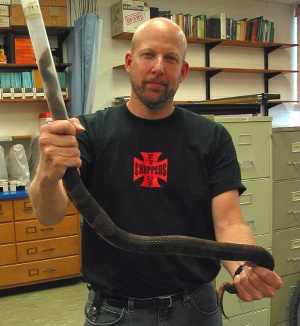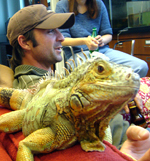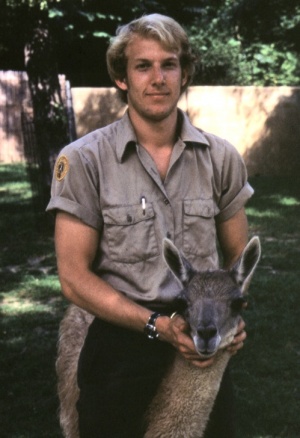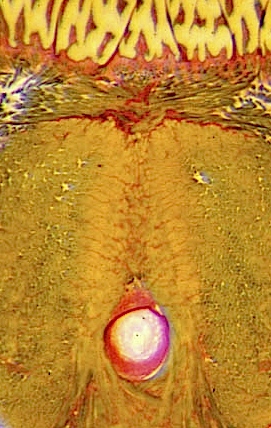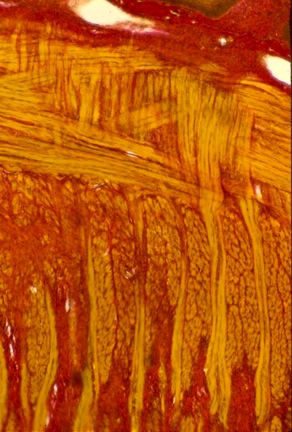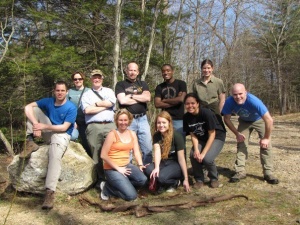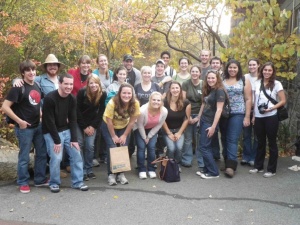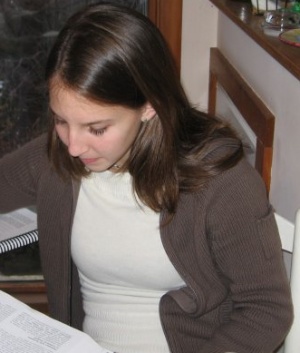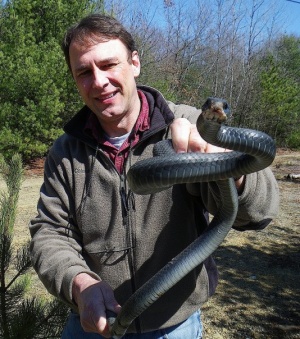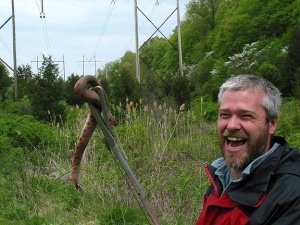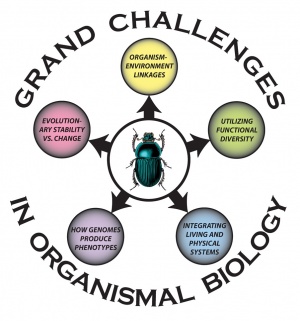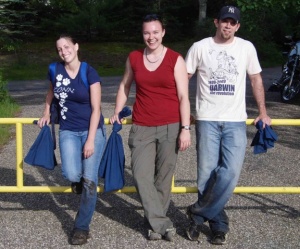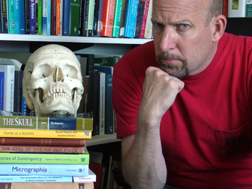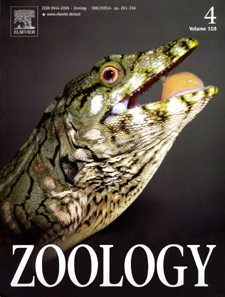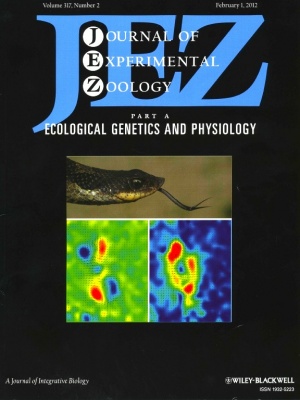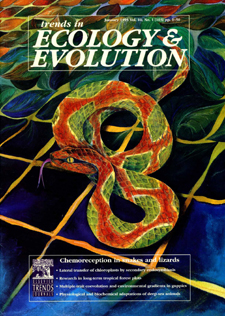Difference between revisions of "Kurt Schwenk"
Kurt Schwenk (Talk | contribs) |
Kurt Schwenk (Talk | contribs) |
||
| (10 intermediate revisions by the same user not shown) | |||
| Line 163: | Line 163: | ||
'''Email for reprints not available here as pdfs: kurt.schwenk@uconn.edu'''<br><br> | '''Email for reprints not available here as pdfs: kurt.schwenk@uconn.edu'''<br><br> | ||
| − | [[Image:FeedingCover_sm.jpg |thumb|left|[http://www.amazon.com/Feeding-Function-Evolution-Tetrapod-Vertebrates/dp/0126325901/ref=sr_1_1?ie=UTF8&s=books&qid=1210882374&sr=1-1 '''Buy it now!'''] | + | [[Image:FeedingCover_sm.jpg |thumb|left|[http://www.amazon.com/Feeding-Function-Evolution-Tetrapod-Vertebrates/dp/0126325901/ref=sr_1_1?ie=UTF8&s=books&qid=1210882374&sr=1-1 '''Buy it now!'''] Now out of print—available for $240!... (or better yet, email me and other authors for free reprints of their chapters!)]] |
<h2 style=font-size:115%>'''BOOKS:'''</h2> | <h2 style=font-size:115%>'''BOOKS:'''</h2> | ||
Schwenk, K. (editor) (2000) ''Feeding: Form, Function and Evolution in Tetrapod Vertebrates''. Academic Press, San Diego. xv + 537 pp.<br><br> | Schwenk, K. (editor) (2000) ''Feeding: Form, Function and Evolution in Tetrapod Vertebrates''. Academic Press, San Diego. xv + 537 pp.<br><br> | ||
| + | |||
| + | REVIEWS: | ||
| + | :*''Quarterly Review of Biology'' {{pdf|http://hydrodictyon.eeb.uconn.edu/people/schwenk/.pdf}} | ||
| + | :*''Copeia'' {{pdf|http://hydrodictyon.eeb.uconn.edu/people/schwenk/.pdf}} | ||
| + | :*'''' {{pdf|http://hydrodictyon.eeb.uconn.edu/people/schwenk/.pdf}} | ||
Schwenk, K. and G. P. Wagner. ''Evolutionary Constraint'' (in preparation)<br><br> | Schwenk, K. and G. P. Wagner. ''Evolutionary Constraint'' (in preparation)<br><br> | ||
| Line 192: | Line 197: | ||
:*UConn Today—[http://today.uconn.edu/blog/2011/04/snakes-lizards-and-tongues/''Snakes, Lizards, and Tongues''] | :*UConn Today—[http://today.uconn.edu/blog/2011/04/snakes-lizards-and-tongues/''Snakes, Lizards, and Tongues''] | ||
:*UConn Magazine—''Studying Snakes'' {{pdf|http://hydrodictyon.eeb.uconn.edu/people/schwenk/UConnMagBlurb11.pdf}} | :*UConn Magazine—''Studying Snakes'' {{pdf|http://hydrodictyon.eeb.uconn.edu/people/schwenk/UConnMagBlurb11.pdf}} | ||
| − | :*'Super Slo-Mo Tuesdays', ''Daily Planet'', Discovery Channel, Canada<br><br> | + | :*'Super Slo-Mo Tuesdays', ''Daily Planet'', Discovery Channel, Canada |
| + | :*''New Scientist,'' on Bill's SICB presentation on aquatic tongue-flicking in ''Nerodia'' (forthcoming)<br><br> | ||
'''Filoramo, N.''', and K. Schwenk. Tongue tips, tropotaxis and the mechanism of chemical delivery to the vomeronasal organs in fork-tongued squamates (Reptilia) (in prep)<br><br> | '''Filoramo, N.''', and K. Schwenk. Tongue tips, tropotaxis and the mechanism of chemical delivery to the vomeronasal organs in fork-tongued squamates (Reptilia) (in prep)<br><br> | ||
| Line 260: | Line 266: | ||
Vitt, L. J., E. R. Pianka, W. E. Cooper and K. Schwenk (2003) History and the global ecology of squamate reptiles. American Naturalist 162:44-60. {{pdf|http://hydrodictyon.eeb.uconn.edu/people/schwenk/VittEAAmNat03.pdf}}<br><br> | Vitt, L. J., E. R. Pianka, W. E. Cooper and K. Schwenk (2003) History and the global ecology of squamate reptiles. American Naturalist 162:44-60. {{pdf|http://hydrodictyon.eeb.uconn.edu/people/schwenk/VittEAAmNat03.pdf}}<br><br> | ||
| − | Schwenk, K., and G. P. Wagner. (2003) Constraint. Pp. 52-61. In: ''Key Words and Concepts in Evolutionary Developmental Biology''. B. K. Hall & W. M. Olson (eds.). Harvard University Press, Cambridge. {{pdf|http://hydrodictyon.eeb.uconn.edu/people/schwenk/SchwenkWagnerConstraint03.pdf}} | + | Schwenk, K., and G. P. Wagner. (2003) Constraint. Pp. 52-61. In: ''Key Words and Concepts in Evolutionary Developmental Biology''. B. K. Hall & W. M. Olson (eds.). Harvard University Press, Cambridge. {{pdf|http://hydrodictyon.eeb.uconn.edu/people/schwenk/SchwenkWagnerConstraint03.pdf}}<br><br> |
Schwenk, K. (2002) Constraint. Pp. 196-199. In: ''Encyclopedia of Evolution'', M. Pagel (ed.). Oxford Univ. Press, Oxford. {{pdf|http://hydrodictyon.eeb.uconn.edu/people/schwenk/SchwenkConstraint02.pdf}}<br><br> | Schwenk, K. (2002) Constraint. Pp. 196-199. In: ''Encyclopedia of Evolution'', M. Pagel (ed.). Oxford Univ. Press, Oxford. {{pdf|http://hydrodictyon.eeb.uconn.edu/people/schwenk/SchwenkConstraint02.pdf}}<br><br> | ||
| Line 282: | Line 288: | ||
Schwenk, K. (2000) Preface. Pp. xiii-xv. In: ''Feeding: Form, Function and Evolution in Tetrapod Vertebrates''. K. Schwenk (ed.). Academic Press, San Diego. {{pdf|http://hydrodictyon.eeb.uconn.edu/people/schwenk/SchwenkFeedPreface00.pdf}}<br><br> | Schwenk, K. (2000) Preface. Pp. xiii-xv. In: ''Feeding: Form, Function and Evolution in Tetrapod Vertebrates''. K. Schwenk (ed.). Academic Press, San Diego. {{pdf|http://hydrodictyon.eeb.uconn.edu/people/schwenk/SchwenkFeedPreface00.pdf}}<br><br> | ||
| − | Schwenk, K. (2000) Tetrapod feeding in the context of vertebrate morphology. Pp. 3-20. In: ''Feeding: Form, Function and Evolution in Tetrapod Vertebrates''. K. Schwenk (ed.). Academic Press, San Diego. | + | Schwenk, K. (2000) Tetrapod feeding in the context of vertebrate morphology. Pp. 3-20. In: ''Feeding: Form, Function and Evolution in Tetrapod Vertebrates''. K. Schwenk (ed.). Academic Press, San Diego. {{pdf|http://hydrodictyon.eeb.uconn.edu/people/schwenk/SchwenkFeedTetMorph00.pdf}}<br><br> |
| − | Schwenk, K. (2000) An introduction to tetrapod feeding. Pp. 21-61. In: ''Feeding: Form, Function and Evolution in Tetrapod Vertebrates''. K. Schwenk (ed.). Academic Press, San Diego. | + | Schwenk, K. (2000) An introduction to tetrapod feeding. Pp. 21-61. In: ''Feeding: Form, Function and Evolution in Tetrapod Vertebrates''. K. Schwenk (ed.). Academic Press, San Diego. {{pdf|http://hydrodictyon.eeb.uconn.edu/people/schwenk/SchwenkFeedIntro00.pdf}}<br><br> |
Schwenk, K. (2000) Feeding in lepidosaurs. Pp. 175-291. In: ''Feeding: Form, Function and Evolution in Tetrapod Vertebrates''. K. Schwenk (ed.). Academic Press, San Diego.<br> | Schwenk, K. (2000) Feeding in lepidosaurs. Pp. 175-291. In: ''Feeding: Form, Function and Evolution in Tetrapod Vertebrates''. K. Schwenk (ed.). Academic Press, San Diego.<br> | ||
| Line 303: | Line 309: | ||
Pigliucci, M., C. D. Schlichting, C. S. Jones and K. Schwenk (1996) Developmental reaction norms: the interactions among allometry, ontogeny and plasticity. Plant Species Biology 11:69-85.<br><br> | Pigliucci, M., C. D. Schlichting, C. S. Jones and K. Schwenk (1996) Developmental reaction norms: the interactions among allometry, ontogeny and plasticity. Plant Species Biology 11:69-85.<br><br> | ||
| − | |||
| − | |||
| − | |||
[[Image:TREECover95_sm.jpg |thumb|right|Schwenk (1995)]] | [[Image:TREECover95_sm.jpg |thumb|right|Schwenk (1995)]] | ||
| + | [[Image:NaturalHistoryCover95_sm.jpg |thumb|right|Schwenk (1995)]] | ||
| + | |||
| + | Schwenk, K. (1996) REVIEW OF: ''Vertebrate Life'', 4th ed., by F. H. Pough et al., Quart. Rev. Biol. 71:581-582.<br><br> | ||
Schwenk, K. (1995) REVIEW OF: ''The Lizard Man Speaks'', by E. R. Pianka. Quart. Rev. Biol. 70:328-329. {{pdf|http://hydrodictyon.eeb.uconn.edu/people/schwenk/SchwenkREVIEWPiankaQRB95.pdf}}<br><br> | Schwenk, K. (1995) REVIEW OF: ''The Lizard Man Speaks'', by E. R. Pianka. Quart. Rev. Biol. 70:328-329. {{pdf|http://hydrodictyon.eeb.uconn.edu/people/schwenk/SchwenkREVIEWPiankaQRB95.pdf}}<br><br> | ||
| Line 343: | Line 349: | ||
:*''Scholastic Super Science" {{pdf|http://hydrodictyon.eeb.uconn.edu/people/schwenk/ScholasticSuperScience07.pdf}} | :*''Scholastic Super Science" {{pdf|http://hydrodictyon.eeb.uconn.edu/people/schwenk/ScholasticSuperScience07.pdf}} | ||
:*''International Wildlife'' | :*''International Wildlife'' | ||
| − | :*''Wilson Quarterly'' | + | :*''Wilson Quarterly'' {{pdf|http://hydrodictyon.eeb.uconn.edu/people/schwenk/ForkedTongueCommentWilsonQuart95.pdf}} |
:*''Washington Post'' | :*''Washington Post'' | ||
:*''USA Today'' (front page: {{pdf|http://hydrodictyon.eeb.uconn.edu/people/schwenk/USATodayForkTongue.pdf}}) | :*''USA Today'' (front page: {{pdf|http://hydrodictyon.eeb.uconn.edu/people/schwenk/USATodayForkTongue.pdf}}) | ||
| Line 354: | Line 360: | ||
:*''Manchester Journal Inquirer'' | :*''Manchester Journal Inquirer'' | ||
:*''San Jose Mercury News'' | :*''San Jose Mercury News'' | ||
| − | :*''Willimantic Chronicle' | + | :*''Willimantic Chronicle'' |
| + | :*''College and University Dialogue'' (Adventist journal) {{pdf|http://hydrodictyon.eeb.uconn.edu/people/schwenk/DialogueAdventistSnakeTongue96.pdf}}) | ||
:*''Encyclopaedia Britanica Yearbook of Science and the Future'' (1995) | :*''Encyclopaedia Britanica Yearbook of Science and the Future'' (1995) | ||
:*''Blue Genes and Polyester Plants'', by S. McGrayne (1997) | :*''Blue Genes and Polyester Plants'', by S. McGrayne (1997) | ||
| Line 379: | Line 386: | ||
Schwenk, K. and D. A. Bell (1988) A cryptic intermediate in the evolution of chameleon tongue projection. Experientia 44:697-700. {{pdf|http://hydrodictyon.eeb.uconn.edu/people/schwenk/SchwenkBellChamTongue88.pdf}}<br><br> | Schwenk, K. and D. A. Bell (1988) A cryptic intermediate in the evolution of chameleon tongue projection. Experientia 44:697-700. {{pdf|http://hydrodictyon.eeb.uconn.edu/people/schwenk/SchwenkBellChamTongue88.pdf}}<br><br> | ||
| − | Schwenk, K. (1988) Comparative morphology of the lepidosaur tongue and its relevance to squamate phylogeny. In: R. Estes & G. Pregill (eds.). ''Phylogenetic Relationships of the Lizard Families''. Stanford Univ. Press, Stanford, 569-598. | + | Schwenk, K. (1988) Comparative morphology of the lepidosaur tongue and its relevance to squamate phylogeny. In: R. Estes & G. Pregill (eds.). ''Phylogenetic Relationships of the Lizard Families''. Stanford Univ. Press, Stanford, 569-598. {{pdf|http://hydrodictyon.eeb.uconn.edu/people/schwenk/Schwenk1988lg.pdf}}<br><br> |
Schwenk, K. and H. W. Greene (1987) Water collection and drinking in ''Phrynocephalus helioscopus'': a possible condensation mechanism. J. Herpetology 21:134-139. {{pdf|http://hydrodictyon.eeb.uconn.edu/people/schwenk/SchwenkGreenePhrynocephalus87.pdf}}<br><br> | Schwenk, K. and H. W. Greene (1987) Water collection and drinking in ''Phrynocephalus helioscopus'': a possible condensation mechanism. J. Herpetology 21:134-139. {{pdf|http://hydrodictyon.eeb.uconn.edu/people/schwenk/SchwenkGreenePhrynocephalus87.pdf}}<br><br> | ||
Revision as of 03:47, 24 February 2013
Professor of Ecology and Evolutionary Biology (Ph.D., University of California, Berkeley)
Contents
- 1
- 1.1 CONTACT INFORMATION
- 1.2 EDUCATIONAL AND PROFESSIONAL HISTORY
- 1.3 RELATED LINKS AND DOWNLOADS
- 1.4 COURSE LINKS
- 1.5 PUBLIC INFORMATION PAGE SERIES (LINKS)
- 1.6 MAJOR RESEARCH INTERESTS
- 1.7 INFORMATION FOR PROSPECTIVE GRADUATE STUDENTS
- 1.8 NSF/SICB INITIATIVE: GRAND CHALLENGES IN ORGANISMAL BIOLOGY
- 1.9 PUBLICATIONS
- 1.10 BOOKS:
- 1.11 EDITED COMPILATION:
- 1.12 PAPERS, BOOK CHAPTERS AND REVIEWS:
CONTACT INFORMATION
Office: Pharmacy-Biology Building Rm. 600
Lab: Pharm-Bio 410, 412
Office phone: (860) 486-0351
Lab phone: 860-486-4158
Fax: (860) 486-6364
Email: kurt.schwenk@uconn.edu
Mailing Address:
Department of Ecology and Evolutionary Biology
University of Connecticut
75 N. Eagleville Road
Storrs, CT 06269-3043
EDUCATIONAL AND PROFESSIONAL HISTORY
- 1976: Zookeeper (intern): Bronx Zoo (Herpetology)
- 1977: B.A. (high honors) Oberlin College, studied with Warren F. Walker, Jr., and Jim Stewart
- 1977-78: Zookeeper: Bronx Zoo (Mammalogy)
- 1984: Ph.D. Dept. of Zoology (now within Integrative Biology), University of California, Berkeley, with Marvalee H. Wake
- 1984-87: Postdoctoral Research Associate, Instructor in Anatomy: Dept. of Oral Anatomy (now within Oral Biology), University of Illinois at Chicago College of Dentistry with Karen Hiiemae (deceased, 2007)
- 1987-89: NIH Postdoctoral Fellow, Lecturer on Biology: Museum of Comparative Zoology, Dept. of Organismic Biology, Harvard University with Fuzz Crompton
- 1989-present: Assistant, Associate and Full Professor: Dept. of Ecology & Evolutionary Biology, University of Connecticut
- 2007-09: Chair, Division of Vertebrate Morphology (DVM), Society for Integrative and Comparative Biology (SICB)
- 2004-06: Associate Editor, Evolution
- 2006-10: Associate Editor, Journal of Comparative Zoology Part A: Ecological Genetics and Physiology
- 2006-present: Editorial Board, Journal of Anatomy
- 2010-present: Editorial Board, Journal of Comparative Zoology Part A: Ecological Genetics and Physiology.
RELATED LINKS AND DOWNLOADS
- My CV
- Schwenk Lab Page (under construction)
- My Classic Works in Evolutionary Biology pages: Introduction and Annotated List
- My Guide to Scientific Paper Citation Formatfor undergraduates
- PhD student Bill Ryerson's page
- Former PhD student Dr. Tobias Landberg's page (postdoc with Howard Whiteman, Murray State Univ, KY)
- Former PhD student Dr. Nirvana Filoramo's page (Asst. Prof, Worcester State Univ., MA)
- Former PhD student Dr. Chuck Smith's page (Asst. Prof., Wofford College, SC)
- Collaborator, Gunter Wagner's page (Yale Univ., CT)
- My brother John Schwenk's page (follow link to view some of my father's [George Schwenk] paintings)
- Schwenk the World (too weird to explain—you have to see for yourself...)
COURSE LINKS
- BIO 1102 Foundations of Biology
- (spring 2010)
- EEB 3273 Comparative Vertebrate Anatomy
- (spring 2010; next offered fall, 2012)
- EEB 3254/5254 Mammalogy
- Mammalogy Class Pictures Page
- (spring 2011; next offered fall 2013)
- EEB 2245W EEB 2245W Schwenk Section Page
- EEB 2245W MAIN PAGE
- (spring 2012)
PUBLIC INFORMATION PAGE SERIES (LINKS)
The list below represents a series of public information pages I will be creating to address commonly asked questions about biological issues—particularly issues and questions about vertebrate animals that I have direct or personal knowledge of. I have been motivated to create these pages because of running across web pages that purport to provide 'answers' to people's questions about animals, evolution and biology generally. While some of the information available on the web is reasonably accurate, I have found that most of it is misleading or downright erroneous. The 'answers' are usually written by people who, although good-intentioned, are mostly ignorant about the topics they address. In any case, the information is nearly always cobbled together from secondary and tertiary sources of information—or worse—rather than direct knowledge of the science or the primary literature on the topic. The aim of these pages, therefore, is to provide accurate, scientifically validated information on some topics in my areas of expertise that come to my attention as being of general interest. I was motivated to do this mostly because of the widespread misinformation being propagated on the web about the first question, below. Since the information used to 'answer' this question is almost always based on a distorted or misunderstood representation of my own research, it seems appropriate for me to set the record straight.
- 2. Why do snakes flick their tongues? [in preparation]
- 3. How do snakes eat? [in preparation]
- 4. How do lizards eat? [in preparation]
- 5. Can snakes hear? [in preparation]
MAJOR RESEARCH INTERESTS
- Phenotypic evolution
- Evolutionary constraint
- Evolutionary and functional morphology of vertebrates
- Evolutionary and functional morphology of feeding in tetrapod vertebrates, especially lizards
- Evolutionary and functional morphology of chemoreception in lizards and snakes
- Evolutionary and functional morphology of the vertebrate tongue
My research program is three-pronged: I pursue empirical studies related to the functional and evolutionary morphology of squamate feeding and chemoreception, and theoretical work related to phenotypic evolution and evolutionary constraint. Feeding and chemoreception are functionally and evolutionarily related in squamates owing to their shared use of a single, complex organ, the tongue. From a biomechanical point of view, optimization of the tongue for feeding function makes it less effective in (vomeronasal) chemoreception and vice versa. Thus, there is a classic functional (and evolutionary) trade-off between the two principal functions of the tongue. Phylogenetic character analysis reveals how each major clade of squamates has found a unique 'solution' to the problem of this trade-off. The dynamic nature of the evolutionary tension created by competing sources of selection pressure has led to my theoretical work on internal selection, functional integration, phenotypic stability and evolutionary constraint. Much of this work has been done in collaboration with Günter Wagner at Yale University. Although theoretical, the work is firmly grounded in my empirical work on squamate feeding and chemosensory systems, which have proven to be compelling model systems for approaching these broader issues.
INFORMATION FOR PROSPECTIVE GRADUATE STUDENTS
Students in my laboratory develop their own, independent research programs under my supervision. Although I expect there to be some overlap or mutual interest in student projects, I do not require students to work in my specific research areas. Ideally students will incorporate elements of morphology, evolution and/or function into their projects. Purely ecological or conservation-related projects are discouraged (because they lie outside my areas of expertise), although these can be elements of a research program centered on the former topics. Although I am best able to supervise work on squamate reptiles, I am open to projects dealing with any vertebrate group. I principally do laboratory-based work, but recent graduate students have included significant field components in their research. Applications from potential doctoral students are preferred, but doing a Masters is also possible.
The Department of Ecology and Evolutionary Biology at UConn is very integrative and interactive, and there is a great deal of cross-fertilization among labs. The department comprises 30 full-time faculty, all of whom work in the general area of organismal biology. There are an additional 60+ biologists in our sister departments of Physiology and Neurobiology, and Molecular and Cell Biology - and this is not to mention a variety of wildlife biologists in the School of Agriculture, biomedical researchers in the School of Medicine, etc. Thus, there is virtually no area of expertise unavailable to students when they assemble their research advisory committees.
There are eight vertebrate biology faculty in the department (4 herpetology, 2 ornithology, 1 ichthyology, 1 mammalogy), and along with postdocs, graduate and undergraduate students, they constitute a very active and interactive research group. We have informal weekly meetings called Vertlunch in which we read and critique recent papers (and laugh a lot) and every Friday at 4:00 the Schwenk and Rubega labs (and others) meet for Beermorph in which - well, it's pretty self-explanatory. For those morphologists with a developmental bent, we also have sporadic meetings of an Evo-Devo Journal Club in which we read and discuss current literature. And this is not to mention, of course, the frequent graduate seminars on various topics offered by faculty in the department, as well as weekly departmental seminars and occasional 'Tuesday Evening Seminars' run by the EEB graduate students. All-in-all, a very active place where you can be intellectually challenged and exposed to a variety of viewpoints - often while drinking at the same time.
Before applying directly to the department for admission into the graduate program, you should contact me by email and describe your research interests and goals so that we can determine if there is an appropriate match. You should also explore the departmental web page to get as much information about EEB as you can. If you have any questions at all about the department or the University, don't hesitate to email me. I can also put you in touch with current graduate students if you would like to hear about the program from their perspectives.
Students accepted into the doctoral program are guaranteed 5 years of support (mostly by means of Teaching Assistantships). Support beyond 5 years is usually possible for students making good progress, but is not guaranteed. Masters students are guaranteed 2 years of support. The support package includes a tuition waiver and full health benefits.
NSF/SICB INITIATIVE: GRAND CHALLENGES IN ORGANISMAL BIOLOGY
At the January, 2009, annual meeting of the Society for Integrative and Comparative Biology (SICB) in Boston, William Zamer of the National Science Foundation challenged the Society to determine what the 'grand challenge questions' are for future work in organismal biology. As the largest comparative, organismal professional society in the country (and probably the world), SICB was called upon to organize organismal biologists to help shape future funding in the field by identifying integrative and forward-looking research arenas that would not only contribute to basic knowledge in organismal biology, but would also tie-in with interest-areas targeted by the Obama administration. SICB President Rich Satterlie called a series of meetings and discussions among the SICB Executive Committee, and on the basis of these discussions, a four-person subcommittee was appointed, with me as Chair, to produce a brief, initial document to be distributed among NSF staff immediately (as required by NSF's budget meeting schedule). This draft document has been expanded into a full-length manuscript that appeared in the first 2009 issue of the Sociey's journal, Integrative and Comparative Biology. Subsequent issues of the journal feature additional 'perspective' pieces written by other organismal biologists targeting more specific topics. The aim of the documents posted here, as well as the other essays published in ICB, is to stimulate broader discussion in the field about future research initiatives and novel, collaborative and synthetic research directions. SICB (and NSF) hopes that additional discussion will further develop and refine the 'grand challenges' in organismal biology. In the near future, face-to-face meetings are planned to broaden and extend the initiative, and these meetings, it is hoped, will lead to concrete advances and funding opportunities for organismal biology, an area that has been chronically underfunded for many years.
The 'grand challenges' initiative is presently in full swing. Additional essays on organismal biology are appearing regularly in ICB and workshops wer held at the 2010 and 2011 annual SICB meetings directed at broadening participation and developing methods for implementation. I have contributed my own ideas with regard to the latter in an invited BioScience essay (below).
- You can download the preliminary 'grand challenges' NSF document HERE
- You can download a reprint of the published 'grand challenges' paper by Schwenk et al. (from Integrative and Comparative Biology) HERE.
- You can download a reprint of the BioScience 'Viewpoint' essay by Schwenk on strategies for implementing the 'grand challenges' program HERE.
- You can link to the SICB website for further information.
- For other questions/comments, please contact me directly: kurt.schwenk@uconn.edu
PUBLICATIONS
Email for reprints not available here as pdfs: kurt.schwenk@uconn.edu
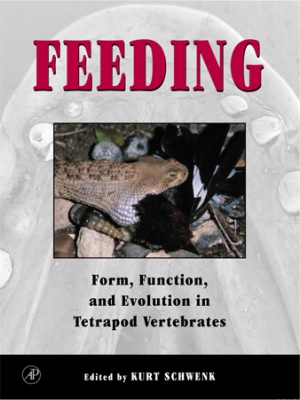
BOOKS:
Schwenk, K. (editor) (2000) Feeding: Form, Function and Evolution in Tetrapod Vertebrates. Academic Press, San Diego. xv + 537 pp.
REVIEWS:
Schwenk, K. and G. P. Wagner. Evolutionary Constraint (in preparation)
EDITED COMPILATION:
Schwenk, K., and J. M. Starck (eds.) (2005) Integrative organismal biology: papers in honor of Professor Marvalee H. Wake. Zoology 108(4):261-356. LINK [email me for a copy of the entire issue]
PAPERS, BOOK CHAPTERS AND REVIEWS:
- (names in bold are current or former students)
- (names in bold are current or former students)
Ryerson, W., and K. Schwenk. Kinematics of chemosensory tongue-flicking in garter snakes (Thamnophis sirtalis) (in prep).
Schwenk, K., and W. Ryerson. Biomechanics of chemosensory tongue-flicking in garter snakes (Thamnophis sirtalis) (in prep).
Ryerson, W., and K. Schwenk. Kinematics of terrestrial versus aquatic chemosensory tongue-flicking in water snakes (Nerodia sipedon) (in prep).
Ryerson, W., and K. Schwenk. Why snakes flick their tongues: the fluid dynamics of chemical sampling (in prep)
- SOME PRE-PUBLICATION PUBLICITY ON THIS TOPIC:
- UConn Today—Snakes, Lizards, and Tongues
- UConn Magazine—Studying Snakes

- 'Super Slo-Mo Tuesdays', Daily Planet, Discovery Channel, Canada
- New Scientist, on Bill's SICB presentation on aquatic tongue-flicking in Nerodia (forthcoming)
Filoramo, N., and K. Schwenk. Tongue tips, tropotaxis and the mechanism of chemical delivery to the vomeronasal organs in fork-tongued squamates (Reptilia) (in prep)
Ryerson, W., and K. Schwenk (2012) A simple, inexpensive system for digital particle image velocimetry (DPIV) in biomechanics. J. Exp. Zool. 317A:127-140.
![]() (JEZA featured paper)
(JEZA featured paper)
Schwenk, K. (2011) Letter to the Editor, Oberlin Alumni Magazine (in response to an article suggesting that social media, e.g., 'tweeting', provide good training for writing). ![]()
Schwenk, K. (2010) Implementing the organismal agenda . BioScience 60:673-674. ![]()
Ryerson, W. and S. Deban (2010) Buccal pumping mechanics of Xenopus laevis tadpoles: effects of biotic and abiotic factors. J. Exp. Biol. 213:2444-2452. ![]()
Schwenk, K., and G. P. Wagner (2010) Visualizing vertebrates: new methods in functional morphology (editorial). J. Exp. Zool. 313A:241-243. ![]()
Flores-Villela, O., C. A. Ríos-Muñoz, K. Schwenk, G. Zamudio-Varela and G. Magaña-Cota (2010) An unpublished manuscript of Alfredo Dugès related to the classification of lizards according to tongue morphology, c. 1898-1899. Archives of Natural History 37:246-254. ![]()
Smith C. F., G. W. Schuett and K. Schwenk (2010) Plasma sex sterioids and mating season in wild-living copperheads (Agkistrodon contortrix) at the northeastern extreme of their range. Journal of Zoology 280:362-370. ![]()
Smith C. F., G. W. Schuett, R. L. Earley, and K. Schwenk. (2009) The spatial and reproductive ecology of copperheads, Agkistrodon contortrix (Serpentes: Viperidae), at the northeastern extreme of their range. Herpetological Monographs 23:43-73.
![]()
Schwenk, K.*, D. Padilla*, G. Bakken* and R. Full* (2009) Grand challenges in organismal biology. Integrative and Comparative Biology 49:7-14. (*authorship equally shared)
![]()
Filoramo, N., and K. Schwenk (2009) The mechanism of chemical delivery to the vomeronasal organs in squamate reptiles: a comparative morphological approach. J. Exp. Zool. 311A:20-34. ![]()
Schwenk, K. (2008) Aristotle’s ghost. Wild River Review. October 2008. [Online reprint of Schwenk (2002)], Wild River Review home page
Sherbrooke, W. C.,* and K. Schwenk.* (2008) Horned lizards (Phrynosoma) incapacitate dangerous ant prey with mucus. J. Exp. Zool. 309A:447-459. (*authorship equally shared) (JEZA featured paper) ![]()
- SOME PRESS ON SHERBROOKE & SCHWENK (2008):
- Journal of Experimental Biology, 'Lizards incapacitate ants with mucus', by Stefan Pulver (see last page of pdf)

- ScienceNOW, 'How to eat a nasty ant', by Greg Miller LINK or pdf

- Natural History (12/08-1/09), 'How to Harvest a Harvester', by Graciela Flores

- The Daily Planet television segment, Discovery Channel (Canada). First broadcast 25 March 2009, approx. 6 min. (working on getting a clip posted)
- Journal of Experimental Biology, 'Lizards incapacitate ants with mucus', by Stefan Pulver (see last page of pdf)
Smith, C. F., K. Schwenk, R. L. Earley and G. W. Schuett (2008) Sexual size dimorphism of the tongue in a North American pitviper. Journal of Zoology 274:367-374. ![]()
Schwenk, K. (2008) Comparative anatomy and physiology of chemical senses in non-avian aquatic reptiles. In: Sensory Evolution on the Threshold. Adaptations in Secondarily Aquatic Vertebrates. J. G. M. Thewissen and S. Nummela (eds.). Univ. of California Press, Berkeley. Pp. 65-81. ![]()
Schwenk, K., and J. G. M. Thewissen (2008) Aquatic and semi-aquatic reptiles. In: Sensory Evolution on the Threshold. Adaptations in Secondarily Aquatic Vertebrates. J. G. M. Thewissen and S. Nummela (eds.). Univ. of California Press, Berkeley. Pp. 7-23. ![]()
Eisthen, H., and Schwenk, K. (2008) The chemical stimulus and its detection. In: Sensory Evolution on the Threshold. Adaptations in Secondarily Aquatic Vertebrates. J. G. M. Thewissen and S. Nummela (eds.). Univ. of California Press, Berkeley. Pp. 35-41. ![]()
Schwenk, K. (2006) Evolution illustrated (Letter to the Editor). The Hartford Courant, 4 March:A9. ![]()
Schwenk, K.,and M. Rubega (2005) Diversity of vertebrate feeding systems. Pp. 1-41. In: Physiological and Ecological Adaptations to Feeding in Vertebrates. J. M. Starck and T. Wang (eds.). Science Publishers, Enfield, NH. ![]()
Schulp, A. S., E. W. A. Mulder and K. Schwenk (2005) Did mosasaurs have forked tongues? Neth. J. Geosci. 84:359-371. ![]()
Schwenk, K. , W. Korff and J. M. Starck (2005) Preface. Integrative organismal biology: papers in honor of Professor Marvalee H. Wake. Zoology 108:261-267. ![]()
Schwenk, K., and G. P. Wagner (2004) The relativism of constraints on phenotypic evolution. Pp. 390-408. In: Phenotypic Integration: Studying the Ecology and Evolution of Complex Phenotypes. M. Pigliucci & K. Preston (eds.). Oxford Univ. Press, Oxford. ![]()
Schwenk, K. (2004) REVIEWS OF: Introduction to Horned Lizards of North America, by Wade C. Sherbrooke, and Horned Lizards: The Book of Horny Toads, by Jane Manaster. Copeia 2004:190-192. ![]()
Schwenk, K. (2004) Leapin’ non-ophidian squamates! REVIEW OF: Lizards. Windows to the Evolution of Diversity, by E. R. Pianka and L. J. Vitt. Trends in Ecology and Evolution 19:357-358. ![]()
Vitt, L. J., E. R. Pianka, W. E. Cooper and K. Schwenk (2003) History and the global ecology of squamate reptiles. American Naturalist 162:44-60. ![]()
Schwenk, K., and G. P. Wagner. (2003) Constraint. Pp. 52-61. In: Key Words and Concepts in Evolutionary Developmental Biology. B. K. Hall & W. M. Olson (eds.). Harvard University Press, Cambridge. ![]()
Schwenk, K. (2002) Constraint. Pp. 196-199. In: Encyclopedia of Evolution, M. Pagel (ed.). Oxford Univ. Press, Oxford. ![]()
Schwenk, K. (2002) Aristotle’s ghost. Creative Nonfiction No.19:32-40 (Special Issue: “Diversity Dialogues”). ![]()
- SOME PRESS ON SCHWENK (2002):
Schwenk, K. (2001) Extrinsic vs. intrinsic lingual muscles: a false dichotomy? Bull. Mus. Comp. Zool. (Harvard) 156:219-235. ![]()
Schwenk, K., and G. P. Wagner (2001) Function and the evolution of phenotypic stability: connecting pattern to process. American Zoologist 41:552-563. ![]()
Schwenk, K. (2001) Functional units and their evolution. Pp. 165-198. In: The Character Concept in Evolutionary Biology. G. P. Wagner (ed.). Academic Press, San Diego. ![]()
Nishikawa, K. C., and K. Schwenk (2001) Ingestion in amphibians and reptiles. In: Encyclopedia of Life Sciences. John Wiley & Sons, Ltd: Chichester [doi:10.1038/npg.els.0001835] (pdf = 7 pp) ![]() LINK TO ELS SITE
LINK TO ELS SITE
Schwenk, K. (2000) The apian way: from beehives to burrows, animal building sheds new light on biology. REVIEW OF: The Extended Organism. The Physiology of Animal-Built Structures, by J. Scott Turner. The New York Times Book Review, 10 Dec., p. 37. ![]() OR SEE IT ONLINE HERE
OR SEE IT ONLINE HERE
Schwenk, K. (2000) Preface. Pp. xiii-xv. In: Feeding: Form, Function and Evolution in Tetrapod Vertebrates. K. Schwenk (ed.). Academic Press, San Diego. ![]()
Schwenk, K. (2000) Tetrapod feeding in the context of vertebrate morphology. Pp. 3-20. In: Feeding: Form, Function and Evolution in Tetrapod Vertebrates. K. Schwenk (ed.). Academic Press, San Diego. ![]()
Schwenk, K. (2000) An introduction to tetrapod feeding. Pp. 21-61. In: Feeding: Form, Function and Evolution in Tetrapod Vertebrates. K. Schwenk (ed.). Academic Press, San Diego. ![]()
Schwenk, K. (2000) Feeding in lepidosaurs. Pp. 175-291. In: Feeding: Form, Function and Evolution in Tetrapod Vertebrates. K. Schwenk (ed.). Academic Press, San Diego.
EMAIL (kurt.schwenk@uconn.edu) FOR HIGH QUALITY HARD COPY
Schwenk, K. (2000) A bibliography of turtle feeding. Pp. 169-171. In: Feeding: Form, Function and Evolution in Tetrapod Vertebrates. K. Schwenk (ed.). Academic Press, San Diego. ![]()
Wagner, G. P.,* and K. Schwenk* (2000) Evolutionarily Stable Configurations: functional integration and the evolution of phenotypic stability. Pp. 155-217. In: Evolutionary Biology, vol. 31. M. K. Hecht, R. J. MacIntyre & M. T. Clegg (eds.). Kluwer Academic/Plenum Press, New York. (*authorship equally shared). YOU CAN DOWNLOAD A PDF OF THIS PAPER HERE
Schwenk, K. (1998) REVIEW OF: Lizards, Vols. 1 & 2. By M. Rogner. Copeia 1998:1114-1116. ![]()
Schwenk, K. (1998) REVIEW OF: Comparative Osteological Examinations of Geckonids, Eublepharids and Uroplatids, by V. Wellborn (translated by A. P. Russell, A. M. Bauer & A. Deufel). Herpetological Translations No. 1. Breck Bartholomew, Bibliomania, Logan, Utah. Copeia 1998:259-260. ![]()
Schwenk, K. (1997) Snakes and the evolution of Harry Greene. REVIEW OF: Snakes. The Evolution of Mystery in Nature, by H. W. Greene. Natural History 106:8-9 (July/August). ![]()
Dial, B. E., and K. Schwenk (1996) Olfaction and predator detection in Coleonyx brevis (Squamata: Eublepharidae) with comments on the functional significance of buccal pulsing in geckos. J. Exp. Zool. 276:415-424. ![]()
Pigliucci, M., C. D. Schlichting, C. S. Jones and K. Schwenk (1996) Developmental reaction norms: the interactions among allometry, ontogeny and plasticity. Plant Species Biology 11:69-85.
Schwenk, K. (1996) REVIEW OF: Vertebrate Life, 4th ed., by F. H. Pough et al., Quart. Rev. Biol. 71:581-582.
Schwenk, K. (1995) REVIEW OF: The Lizard Man Speaks, by E. R. Pianka. Quart. Rev. Biol. 70:328-329. ![]()
Schwenk, K. (1995) Of tongues and noses: chemoreception in lizards and snakes. Trends in Ecology & Evolution 10:7-12. ![]()
Schwenk, K. (1995) A utilitarian approach to evolutionary constraint. Zoology 98:251-262. ![]()
Schwenk, K., and H. W. Greene (1995) No electrostatic sense in snakes. Nature 373:26. ![]()
Schwenk, K. (1995) The serpent's tongue. Natural History 104:48-55 (April). ![]()
Schwenk, K. (1994) Why snakes have forked tongues. Science 263:1573-1577. ![]()
- SOME PRESS ON SCHWENK (1994):
- National Public Radio (All Things Considered) (see The NPR Interviews, 1995. R. Siegel, ed.)
- BBC World News Service
- BBC-4
- Voice of America
- CBC (Canadian Broadcasting Corp.)
- AAAS Science Update (Mutual Radio Network)
- WFIU Radio (Indiana Univ., ‘'A Moment of Science'’)
- ABC news, New Haven, with Geoff Fox (television)
- TV Ontario (segment for children's show)
- Associated Press (newspapers throughout North America and Europe) Example:

- New Scientist
- Chronical of Higher Education

- Discover Magazine
- National Geographic Magazine
- Australia Nature

- Readers' Digest
- Omni Magazine
- Weekly Reader Magazine
- Scholastic Super Science"

- International Wildlife
- Wilson Quarterly

- Washington Post
- USA Today (front page:
 )
) - International Herald Tribune
- Boston Globe
- Daily Telegraph (London)
- La Guardia (Spain)
- Hartford Courant
- New Haven Register''
- Manchester Journal Inquirer
- San Jose Mercury News
- Willimantic Chronicle
- College and University Dialogue (Adventist journal)
 )
) - Encyclopaedia Britanica Yearbook of Science and the Future (1995)
- Blue Genes and Polyester Plants, by S. McGrayne (1997)
- The NPR Interviews, 1995, edited by Robert Siegel (1995)
Schwenk, K. (1994) Craniology: getting a head. REVIEW OF: The Skull, 3 vols. J. Hanken & B. K. Hall (eds.). Science 263:1779-1780. ![]()
Schwenk, K. (1994) Comparative biology and the importance of cladistic classification: a case study from the sensory biology of squamate reptiles. Biological J. Linnean Soc. 52:69-82. ![]()
Schwenk, K. (1994) Systematics and subjectivity: the phylogeny and classification of iguanian lizards reconsidered. Herpetological Review 25:53-57. ![]()
Schwenk, K., and D. B. Wake (1993) Prey processing in Leurognathus marmoratus and the evolution of form and function in desmognathine salamanders (Plethodontidae). Biol. J. Linn. Soc. 49:141-162. ![]()
Schwenk, K. (1993) Are geckos olfactory specialists? J. Zool., Lond. 229:289-302. ![]()
Schwenk, K. (1993) The evolution of chemoreception in squamate reptiles: a phylogenetic approach. Brain, Behavior and Evolution 41:124-137. ![]()
Schwenk, K. and G. C. Mayer (1991) Tongue display in anoles and its evolutionary basis. 4th Anolis Newsletter. J. Losos & G. Mayer (eds.). National Museum of Natural History (Smithsonian), Division of Amphibians and Reptiles, Washington, DC. ![]()
Schwenk, K. (1989) REVIEW OF: The Evolution of Vertebrate Design, by L. B. Radinsky. American Scientist 77:84.
Schwenk, K. and G. S Throckmorton (1989) Functional and evolutionary morphology of lingual feeding in squamate reptiles: phylogenetics and kinematics. J. Zool., Lond. 219:153-175. ![]()
Schwenk, K. and D. A. Bell (1988) A cryptic intermediate in the evolution of chameleon tongue projection. Experientia 44:697-700. ![]()
Schwenk, K. (1988) Comparative morphology of the lepidosaur tongue and its relevance to squamate phylogeny. In: R. Estes & G. Pregill (eds.). Phylogenetic Relationships of the Lizard Families. Stanford Univ. Press, Stanford, 569-598. ![]()
Schwenk, K. and H. W. Greene (1987) Water collection and drinking in Phrynocephalus helioscopus: a possible condensation mechanism. J. Herpetology 21:134-139. ![]()
Schwenk, K. (1986) Morphology of the tongue in the tuatara, Sphenodon punctatus (Reptilia: Lepidosauria), with comments on function and phylogeny. J. Morphology 188:129-156. ![]()
Wake, M. H. and K. Schwenk (1986) A preliminary report on the morphology and distribution of taste buds in gymnophiones, with comparison to other amphibians. J. Herpetology 20:254-256. ![]()
Schwenk, K. (1985) Occurrence, distribution and functional significance of taste buds in lizards. Copeia 1985:91-101. ![]()
Good, D. A., and K. Schwenk (1985) A new species of Abronia (Lacertilia: Anguidae) from Oaxaca, Mexico. Copeia 1985:135-141. ![]()
Schwenk, K. (1984) Evolutionary Morphology of the Lepidosaur Tongue. Ph.D. dissertation, University of California, Berkeley.
Houck, L., and K. Schwenk (1984) The potential for long-term sperm competition in a plethodontid salamander. Herpetologica 40:410-415. ![]()
Jaksic, F. M., and K. Schwenk (1983) Natural history observations on Liolaemus magellanicus, the southernmost lizard in the world. Herpetologica 39:457-461. ![]()
Bemis, W., K. Schwenk and M. H. Wake (1983) Morphology and function of the feeding apparatus in Dermophis mexicanus (Amphibia: Gymnophiona). Zool. J. Linn. Soc. 77:75-96. ![]()
Jaksic, F. M., H. W. Greene, K. Schwenk and R. L. Seib (1982) Predation upon reptiles in Mediterranean habitats of Chile, California, and Spain: a comparative analysis. Oecologia 53:152-159. ![]()
Schwenk, K., S. K. Sessions and D. M. Peccinini-Seale (1982) Karyotypes of the basiliscine lizards Corytophanes cristatus and Corytophanes hernandesii, with comments on the relationship between chromosomal and morphological evolution in lizards. Herpetologica 38:493-501. ![]()
